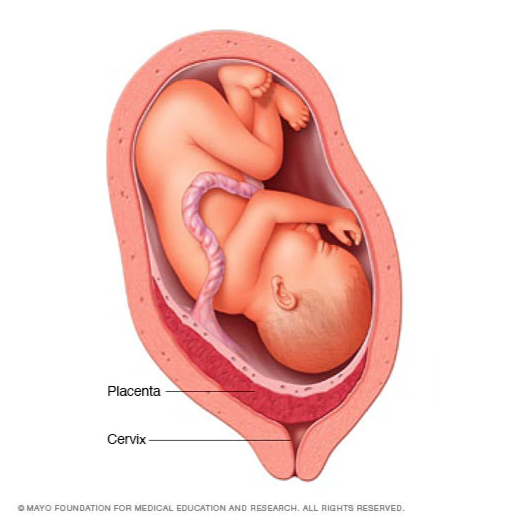Placenta previa always sounds like a horrible breakfast cereal to me. Ok kids, let me pour you a bowl of placenta previa! Now with marshmallows!
In reality, it is the location of the placenta in regard to the cervix. Normally, the placenta is on the top or sides of the uterus. In a previa it is near / touching, partially covering, or completely covering the cervix.
Affecting approximately .5% of pregnancies, it is one of the most common causes of painless bleeding in the third trimester.
Why is placenta previa bad?
Generally speaking, the cervix is the airlock between the baby and the outside world. When the placenta obstructs that exit, it causes a lot of problems.
As the cervix thins and dilates, the placenta loses its attachment to the uterine wall in that area. When this happens, blood vessels tear and results in bleeding. The lower portions of the uterus are less adept at contracting and restricting those vessels. Uncontrolled bleeding is rarely a cause of celebration.

Risk factors
Like usual, nobody knows for sure what causes placenta previa in most cases.
Also like usual, the list of risk factors includes three of the horsemen of the pregpocolypse:
- Advanced maternal age
- Smoking
- Multiple gestation
Additional risk factors include:
- Multipara (having had many pregnancies) – especially close together
- Previous previa
- Previous uterine or cervical surgery (including cesarean section)
- Cocaine use
Placenta Previa Diagnosis
Most previas are diagnosed during routine ultrasounds during the second trimester. At that point you will be given information about the degree of the previa.
- Marginal – The placenta is very close to, or touching, the cervix.
- Partial – The placenta is covering part of the cervix.
- Complete – The placenta is totally obstructing the cervix.
More recently, doctors have begun to use only two descriptors, major and minor.
What next
Here is the good news! Most previas diagnosed in the second trimester – especially marginal and partial ones – resolve themselves.
84% of complete previas and 98% of marginal previas will have resolved by ~28 weeks.
The way I was told to envision it was with the uterus as a balloon. If you blow a balloon up just a little and put a dot on it near the bottom, the dot will move further from the stem of the balloon as it continues to expand.
You will have a follow up ultrasound later in your pregnancy to confirm that the placenta has moved away from your cervix.
In the meantime, you may be put on “pelvic rest,” especially if you have had bleeding. This is mostly a polite way of saying no sex.
My midwife did explicitly say, “nothing inside your vagina, other stuff is ok.” *WINK* *WINK*
In cases of more severe bleeding you may be put on more strict versions of bed rest.
The biggest risks come from the onset of labor. In the case of a marginal previa you may be able to deliver vaginally. In partial or complete previas a cesarean is indicated.
If you are one of the unlucky few for whom the placenta has some sort of unhealthy fondness for your the cervix, preventing labor will be the utmost priority. Therefore, you will likely undergo a routine cesarean section around 36 – 37 weeks.
If you begin bleeding heavily, there is distress in the fetus, or there is evidence of preterm labor, you will deliver earlier.
The scary shit
The risks in the event of major bleeding are similar to that of a placental abruption. Maternal blood loss, postpartum hemorrhage, premature birth, and stillbirth.
Unlike in an abruption scenario, you will know you are at risk and be monitored closely.
Intrauterine Growth Restriction (IUGR) is another potential complication, occurring in approximately 15% of cases and leading to low birth weight.
Placenta Previa Takeaways
If you are diagnosed with placenta previa in the 2nd trimester, don’t panic. I remember my doctor warning me, “don’t Google this.” But since you are here, I’m guessing it’s too late for that. So let me reassure you…
Almost all previas of all severities will resolve themselves long before they are an issue.
And again for those in the back: Almost all previas of all severities will resolve themselves long before they are an issue.
If it doesn’t, you will likely be scheduled for an early-term c-section and monitored closely for any bleeding or issues with the baby.
For more information, head over to the March of Dimes page or check out BabyCenter’s support group.




Leave a Comment